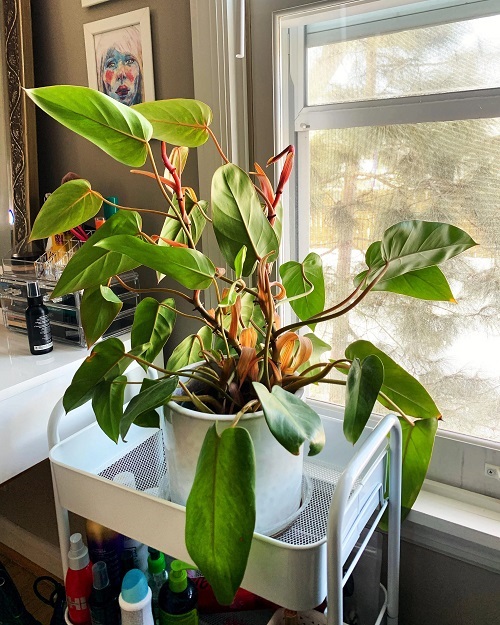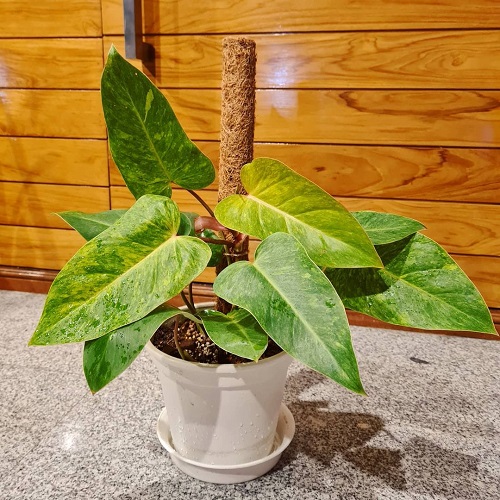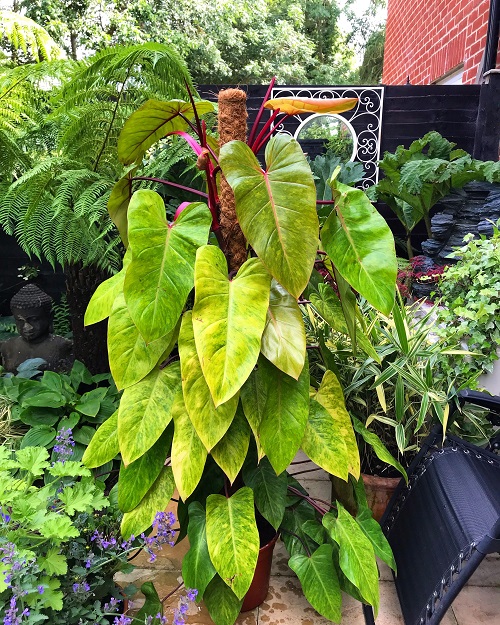Philodendron Painted Lady lives up to its name and stands out with its exceptional green foliage and red stems! Here’s how to grow it!
Prepare to be dazzled by the Philodendron Painted Lady, a houseplant that takes botanical beauty to new artistic heights. With its stunning variegated foliage that merges shades of green and yellow into a painterly masterpiece, this plant is a conversation starter and a feast for the eyes. Want to make this rare gem the crown jewel of your indoor garden? Keep scrolling to unveil the secrets of nurturing it easily.
Here is our Philodendron Jose Buono Care and Growing Guide
Philodendron Painted Lady Information
The Philodendron Painted Lady belongs to the Araceae family, which includes various flowering plants. Native to the tropical regions of Central and South America, this plant thrives in warm and humid environments. It has gained popularity as a houseplant due to its striking appearance and ease of care.
With its unique and eye-catching features, the ‘Painted Lady’ Philodendron stands out among other plants. It showcases heart-shaped leaves that have a glossy texture and vibrant hues. The foliage typically displays a combination of green and yellow tones, creating a stunning contrast. As the plant matures, the leaves may develop intricate patterns, adding to its visual appeal.
The Philodendron Painted Lady has a unique ability to climb and trail. It can grow long vines and attach itself to supports or crawl along surfaces. This climbing behavior makes it a great choice for adding a touch of greenery to vertical spaces or hanging baskets.
Here is our Philodendron Brandi Care and Growing Guide
Propagating Philodendron Painted Lady from Cuttings
Propagating Philodendron Painted Lady is an exciting way to expand your plant collection and share the beauty of this stunning species. Follow these simple steps to propagate your own:
- Choose a stem from the parent plant that is at least 6 inches long and has several leaves.
- Using clean, sharp scissors or pruning shears, cut the stem just below a leaf node (the spot where a leaf emerges from the stem).
- Trim off the lower leaves from the cutting, leaving only a few leaves at the top.
- You have two options for rooting the cutting. Either place it in a glass of water, making sure the nodes are submerged, or directly plant it in a pot filled with well-draining soil.
- Keep the cutting in a warm and bright location, but avoid direct sunlight. Maintain a consistently moist environment for water propagation or lightly water the soil for those planted directly.
- In a few weeks, you should start to see roots forming. Once the roots are well-developed (about 2-4 inches long), you can transplant the cutting into its own pot.
Propagate Any Plant Cutting Quickly Using this Trick
Best Pot for Philodendron Painted Lady
When selecting a pot for your Philodendron Painted Lady, it’s important to consider the appropriate pot size based on the plant’s stage of growth. Choose a pot that is 1-2 inches larger in diameter than the current root ball. You can start the plant in a 6-8-inch pot and then re-pot it into a one-size bigger container than the old one, depending on its growth and spread.
Regardless of the pot size, ensure that the chosen container has drainage holes at the bottom. These holes prevent water from accumulating and causing root rot.
Here are Plant Pot Sizes from Inches to Gallon
Requirements for Growing Philodendron Painted Lady
Sunlight
Place your Philodendron Painted Lady in a well-lit location with bright, indirect light. It enjoys a spot near a window where it can receive filtered sunlight throughout the day.
If you don’t have a well-lit area, this plant can also tolerate lower light conditions like a pro, but it may grow slower.
Soil
Choose a well-draining soil mix for your Philodendron Painted Lady. A high-quality potting mix that contains peat and perlite or vermiculite works well. go for:
- 50% Peat Moss or Coco Coir
- 30% Perlite or Pumice
- 20% Compost or Worm Castings
Learn some Great Tips to Rejuvenate Your Old Soil here
This type of soil allows water to flow through easily, preventing waterlogged roots and ensuring proper aeration.
Water
Water your Philodendron when the top inch of soil feels slightly dry to the touch. Give it a thorough watering, allowing excess water to drain out from the bottom of the pot.
Here are the best ways to water plants
During the winter months, reduce watering frequency slightly to account for the plant’s slower growth.
Temperature and Humidity
Philodendron Painted Lady prefers temperatures between 65°F (18°C) and 85°F (29°C), but it can tolerate slightly lower temperatures. Protect it from cold drafts and frost, as they can damage the plant.
You should maintain moderate to high humidity levels around 50%-70% to keep the foliage healthy. You can increase humidity by using a humidifier, placing a water-filled tray near the plant, or misting the leaves regularly.
Check out these 10 Ways To Increase Humidity For Houseplants That Work
Philodendron Painted Lady Care

Fertilizer
Keep your Philodendron Painted Lady nourished by applying a balanced, water-soluble houseplant fertilizer during the growing season (spring and summer). You should dilute the fertilizer as directed on the package and feed your plant every 4-6 weeks.
Want to Make Organic Fertilizers from Kitchen Scraps? Click here
However, remember to reduce or stop fertilization during the dormant period (fall and winter) as the plant’s growth slows down.
Pruning
Regular pruning is essential to keep this Philodendron in shape and ensure its well-being. Simply trim off any yellowed or damaged leaves at the base to maintain the plant’s overall health.
If you desire a more compact and bushier growth, you can trim back the stems to your preferred length. To prevent the spread of diseases, remember to use clean pruning shears or scissors each time you prune your plant.
Pests and Diseases
While the Philodendron Painted Lady is typically resilient to pests and diseases, it’s essential to stay vigilant. Keep an eye out for common issues like mealybugs, spider mites, and aphids. If you spot any infestations, gently wipe the leaves with a damp cloth or employ insecticidal soap to control the pests.
Click here to learn the Amazing Natural Pesticide Recipe that can Kill any Pest
To prevent root rot, avoid overwatering and ensure proper drainage. If you observe brown spots or excessive drooping of the leaves, adjust your watering routine or increase humidity levels as needed.





